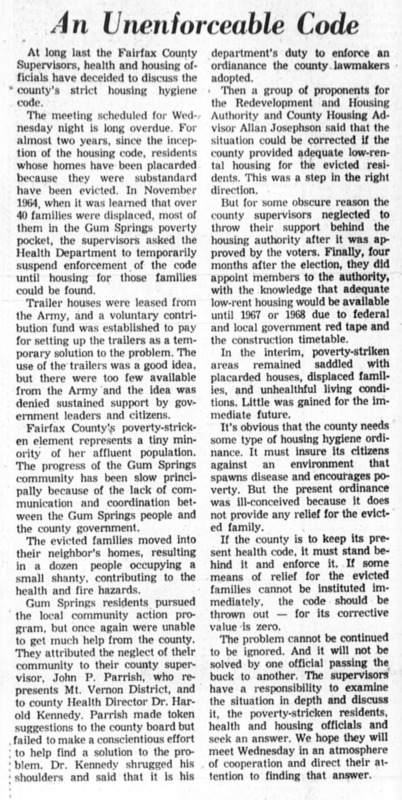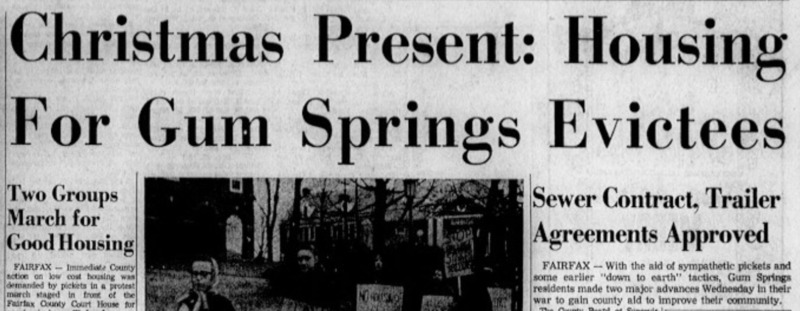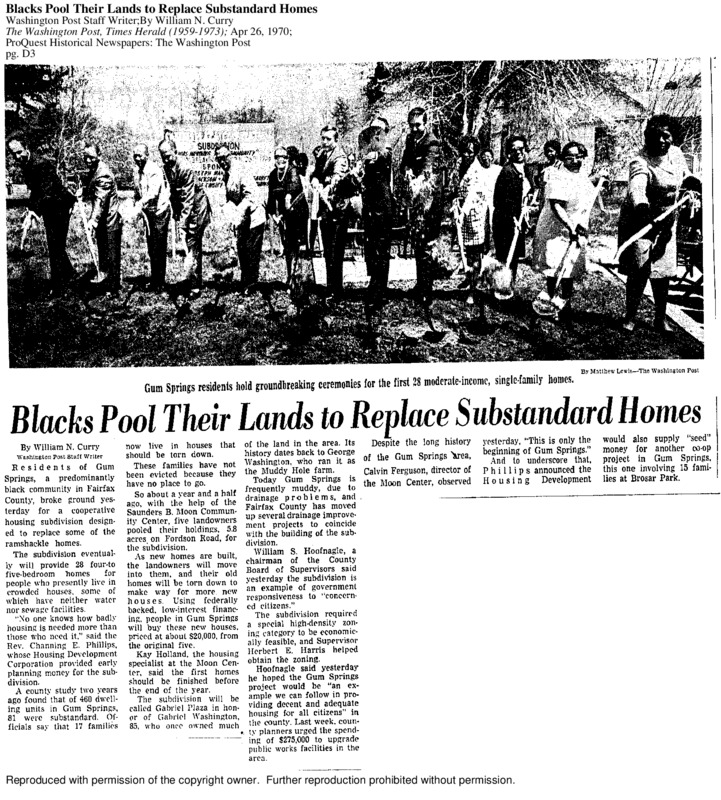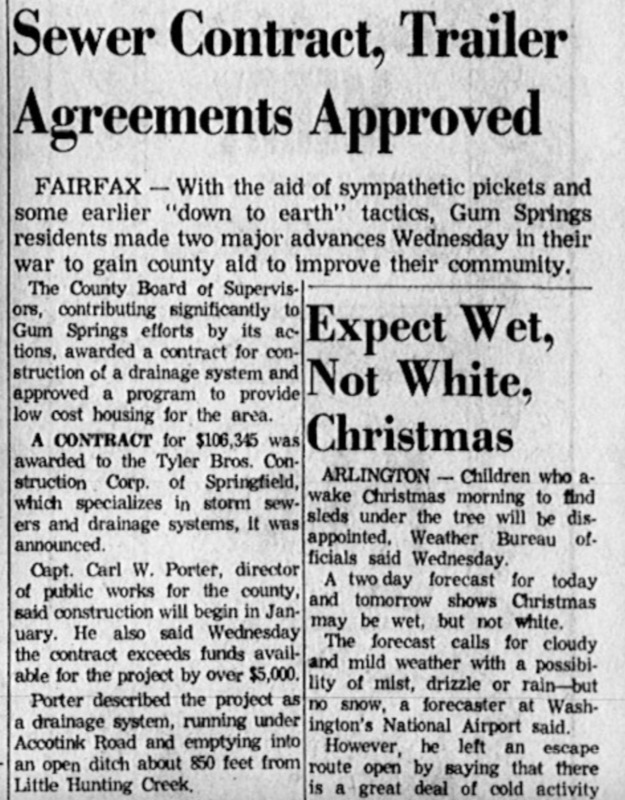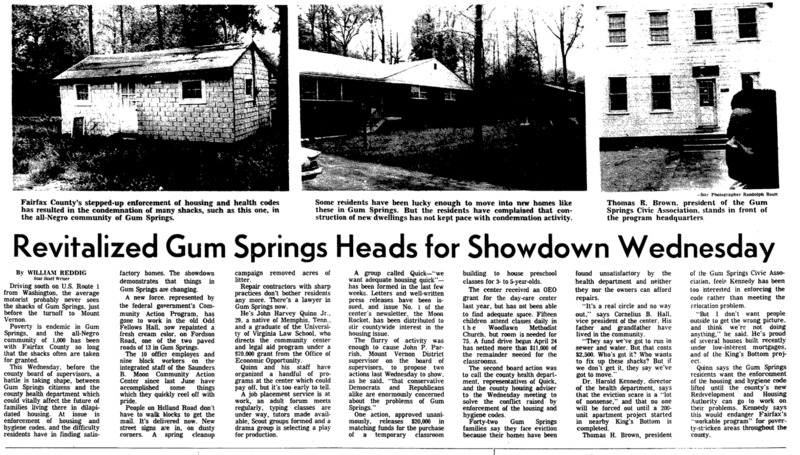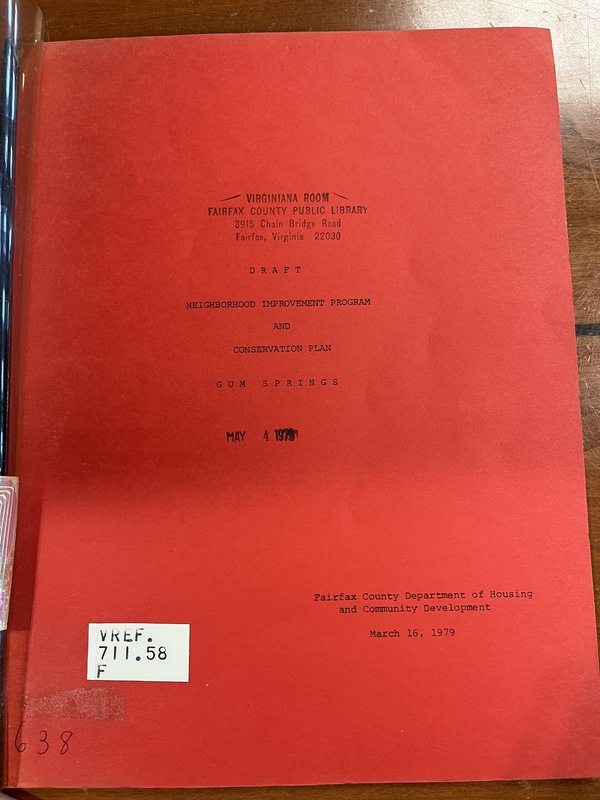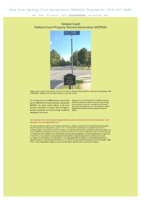Gum Springs: Community Action Then and Now
The community of Gum Springs had and still has a strong community structure. From its genesis, familial bonds were strong throughout the Gum Springs community. They tied its people to its land, and these bonds made the community outlast the multifaceted forms of displacement that it faced. There is a long history of Black organizing and fighting for rights and claims to space in Gum Springs, going back to community enterprises in the Gum Springs Joint Stock Club who came together in 1890 to pool their resources and purchase 50 acres of land in Gum Springs.[1] For decades, community structures have kept Gum Springs afloat throughout its most challenging moments by utilizing multiple methods to maintain its claims of space and place. The three most apparent forms of resistance come from organizing, using federally and publicly funded aid, and community-driven mutual aid projects. While the needs of Gum Springs in the decades following the 1980s have primarily stayed the same, community organization and community planning have remained central. Nevertheless, these structures in Gum Springs sit in precarity just as they did more than sixty years ago as similar pressures leave the community with reminiscent problems, and a recalcitrant county government that has at times failed to aid them in their most significant needs in the past three decades.
Community organizations have a long history in Gum Springs. Historically, the largest groups included the Odd Fellows Masonic Order (Odd Fellows), the Gum Springs Civic Association (GSCA)*, the Saunders B. Moon Community Action Association (SBM), and today, the New Gum Springs Civic Association. The power of community organizing is vital to the survival of Gum Springs, particularly the work of community organizing during the tumultuous period of the 1950s-1970s. As the community sought to challenge the economic downturn, break free of constrained livelihoods, and assert their place in the County, their work was essential to achieving better housing, education, and job opportunities.
Locations like Odd Fellows Hall, home of the Odd Fellows, provided a space for the community to unite and build resistance. The location was integral to the community throughout the Civil Rights era and remains today as a lodge for the Pride of Fairfax County order of the GCOESVA, still used for community events.[2] Organizing groups like the Gum GSCA and the SBM provided civic pillars for the community and acted as means of making their voices heard. Community action in the days before the SBM was primarily driven by the GSCA. The GSCA, whose name appears throughout articles, organized a robust campaign against the housing hygiene ordinance. The GSCA is present, making its voice heard, and always fighting for Gum Springs.[3]
However, the most prominent from 1965 onward is the SBM. Born out of the Economic Opportunity Act of 1964 and its creation of Community Action Program funding, the SBM was named after Saunders B. Moon, a community organizer, leader, and former principal of Drew Elementary.[4] The work of the SBM is central to Gum Springs's resistance, as it acted as a place of employment and a progenitor of countless community achievements to improve education, housing, and employment.
Their first success was creating a daycare center for Gum Springs children.[5] Following this, their successes include creating the SBM Housing Development Corporation, which provided the housing grant system utilizing federal aid money through the Department of Housing and Urban Development and local public and private funds.[6] Following this, the SBM, fighting in tandem with the GSCA, turned its aim to the hygiene ordinance. In 1966, they forced the mandating of an automatic eviction appeal in the housing hygiene ordinance.[7] After half a decade of looming evictions in the 1960s and a local County Supervisor who stood in the way of relieving Gum Springs residents, the SBM and GSCA provided relief for many families with the mandated appeal.
Following this, the SBM began to provide housing opportunities for many in the community. A standout in their success is the creation of the Gabriel Plaza Subdivision in 1970. Hearkening back to the early days of Gum Springs and the Gum Springs Joint Stock Company, five landowners came to the SBM with a plan to pool their 5.8 acres of land.[8] The outcome was a 28-home cooperative housing subdivision that replaced substandard homes using federally backed low-interest financing. In the decades following its creation, the SBM provided housing and employment opportunities for the community through its Community Action Association and the Housing Development Corporation.
Through community organizing through community action groups, long-existing structures like the Odd Fellows, public and private aid through the SBM, and mutual aid/community projects, Gum Springs achieved a higher standard of living and better opportunities for many of its residents. Methods of resistance against displacement in place and physical displacement varied through the years, but at the heart of it lay the community spirit – the driving force of Gum Springs. Protests, organizing, and resistance were not always born of community groups, and they sometimes even relied on groups outside Gum Springs, like the Congress of Racial Equality.[9] However, groups like the SBM and the GSCA were vital to these community efforts. Ultimately, these groups could not outlast the turn of the century as the situations in Gum Springs and funding evolved with new and old challenges.
Throughout mass suburbanization in Northern Virginia and Fairfax County (1950-1980), Gum Springs residents fought to achieve fair funding to improve their community. Housing, employment, and achieving an adequate income remain the biggest concerns for Gum Springs residents while maintaining their claims to space and community foregrounding this discussion. This section examines the period from 1980 to today. It assesses how community structures have evolved in Gum Springs, examining how they continue to maintain and fight for their community and what they face in the coming years as similar pressures have them dealing with deeply reminiscent problems of expansion and land maintenance, housing precarity, and a recalcitrant county government.
After nearly two decades of continual housing hygiene ordinance problems and looming precarity from evictions, Gum Springs won a long-term conservation plan. Through community efforts and funding backed by the County, the 1979 Neighborhood Improvement Program and Conservation Plan (1979 Conservation Plan) established a system of appropriating funds towards Gum Springs in multiple sectors, including drainage, parks, and housing.[10]
Public facilities that had been lacking and underfunded for decades would be improved, and home-building projects would be funded through block grants. In addition, Gum Springs gained a conservation plan that would help improve and conserve the community by giving community members a stake in the development process and the power to shape who and what would be developed to preserve the historic nature of Gum Springs.[11] This plan was a significant achievement for the Gum Springs community. It provided its residents with a direct line of communication in the development and improvement process – something that had required dramatic organizing efforts in the past.
Similar work was achieved to bolster community structures in the creation of the Gum Springs Historical Society in 1985. Efforts by the Black residents, the SBM, and fellow community organizations in Fairfax made it known that, as the 1979 Conservation Plan did for their land, Gum Springs required a way to conserve their rich Black histories.[12] These conservation efforts established long-term benefits for the Gum Springs community by allowing them to hold onto their land and record and sustain their stories.
Positive strides were made in the community during the 1970s and 1980s with the accomplished efforts of the SBM and conservation efforts. However, this did not end all hardship for the community. The SBM began to lose funding due to shifts in federal policies that brought conservative cuts to public programs. Nixon and Reagan's administrations enacted cuts to Democratic War on Poverty spending that left the SBM with declining funds, and over time, it slowly shrank.[13] Eventually, it shifted to only a housing development corporation in the early 1990s and finally dissolved in 1996.[14] This did not spell the end for community organizing and mutual aid work, as community gathering places once used by the SBM continue to be utilized today.
The Gum Springs Community Center (former home of the SBM) maintains programs for Gum Springs residents, including daycare work, and houses the Gum Springs Historical Society. Over time, the GSCA morphed into the New Gum Springs Civic Association (NGSCA). Today, the NGSCA maintains its fight for the community and represents the social reach of community organizations in Gum Springs. Their work also highlights the ongoing and evolving struggles that Gum Springs faces.
With the conclusion of the 1979 Conservation Plan in 2004, the Gum Springs community no longer had a direct communication pipeline to plan growth and change on their own terms, as they had achieved with the 1979 Conservation Plan. In the years since 2004, the urgency of a new conservation plan by the Gum Springs community has been apparent.[15] Route 1 expansion and creating an incorporated neighborhood of homes on Holland Court, a road in Gum Springs, present direct challenges to community stability and agency, returning displacement in place to the forefront.
The expansion of Route 1 (Richmond Highway), running adjacent to Gum Springs' western border, has been a decades-long struggle. The community of Gum Springs has long opposed the road's expansion and fought for better traffic laws surrounding it as it became dangerous for its residents.[16] Recent expansion plans will expand the road to 11 and 12 lanes, reaching 13 at the southwest edge of Gum Springs.[17] The NGSCA and Gum Springs community members argue that this puts Gum Springs in further danger of encroachment from development and more traffic.[18] As Queenie Cox, former head of the NGSCA, asked: Why are you putting 13 lanes only in the Black community?” [19] Reflecting social hierarchies of racial capitalism, extractive systems of planning and community design, and myths of progress that place the white spatial imaginary as ideal and therefore correct – a Black community like Gum Springs' complaints and fears have been left unheard or unrecognized. Fairfax County and local administrators have failed to listen to their pleas for a new conservation plan, which the NGSCA had drawn up as far back as 2015.[20] Mounting pressure to conserve Gum Springs makes it clear the challenge historically Black communities like Gum Springs face against the continuing redevelopment and gentrification of suburban and commercial developments they outlasted in previous decades.
The pressure for a conservation plan has only mounted for Gum Springs and the NGSCA following the incorporation of the Holland Court/Holland Court Property Owners Association (HCPOA) in 2021. The establishment of an 11-home “property owners association” inside the historic boundaries of Gum Springs is a direct challenge to the community itself, and the NGSCA fought vehemently to have the incorporation of the HCPOA rejected.[21] The creation of the HCPOA inside of Gum Springs is another attack on the community following decades of slow violence, displacement in place, and physical displacement.
While the historic community suffers attrition due to a litany of compounding reasons, many descendants of West Ford and early founding families have staved off physical displacement. However, the fear of looming displacement remains for many of those remaining. Route 1 expansion continues to be a thorn in the community's side. New developments such as the Holland Court/Holland Court Property Owners Association have eaten up land formerly owned by Black residents. In contrast, economic struggles continue to push the community out.
Today, Gum Springs' population demographics have shifted, with many descendants moving out over the last half-century for various reasons.[22] While the Gum Springs community has urged the County to pass a new conservation plan based on one drafted nearly ten years ago, it appears less inclined to listen to their pleas than ever. However, the community structures in Gum Springs still exist in a less effective format than previously achieved during the housing hygiene fight and up to the mid-1980s. However, this does not spell the end for Gum Springs, as the community structures such as Gum Springs Community Center, the Gum Springs Historical Society, and the community itself are still vibrant, with deep roots in a landscape marked with emotional and physical geographies that cannot be displaced. Continued challenges to the community do leave the community in precarity, but the possibilities of harnessing the historic spirit of Gum Springs remains.
[1] David Corbin, Introduction: The Land of Gum Springs (typescript, 1980-1981): 59-60.
*sometimes written as Gum Springs Citizens Association instead of Gum Springs Civic Association
[2] Eric Griffitts, Alyssa Stein, and Carleigh Hamberger, “National Register of Historic Places Registration Form - Mount Vernon Enterprise Lodge #3488/Pride of Fairfax County Lodge #298” (Virginia Department of Historic Resources, December 2021), https://www.dhr.virginia.gov/wp-content/uploads/2021/12/029-6069_Pride_of_Fairfax_County_Lodge_2021_NRHP_FINAL.pdf.
[3] John Lawson, “Fairfax Votes $70,000 For Gum Springs Ditch,” The Evening Star, April 13, 1961, 109th Year, No. 103 edition, America’s Historical Newspapers; William Reddig, “Revitalized Gum Springs Heads for Showdown Wednesday,” The Evening Star, May 16, 1966, 114th Year, No. 136 edition, America’s Historical Newspapers; Fairfax Countywide Citizens Association v. County of Fairfax, Virginia v. County of Fairfax Virginia, 571 F.2d 1299 (Court of Appeals for the Fourth Circuit 1978), https://www.courtlistener.com/opinion/353872/fairfax-countywide-citizens-association-gum-springs-civic-association/.
[4] “Gum Springs Poverty War Contract Signed,” Fairfax County Sun Echo, June 3, 1965, Vol. 26, No. 3 edition, Library of Virginia; “County Anti-Poverty Director Is Selected,” Fairfax County Sun Echo, May 6, 1965, Vol. 26, No. 28 edition, Library of Virginia; Lon Tuck, “Fairfax County’s Gum Springs in Line For First Suburban Poverty Grant,” The Washington Post, February 17, 1965, sec. City Life.
[5] William Reddig, “Revitalized Gum Springs Heads for Showdown Wednesday,” The Evening Star, May 16, 1966, 114th Year, No. 136 edition, America’s Historical Newspapers.
[6] William N. Curry, “Blacks Pool Their Lands to Replace Substandard Homes,” The Washington Post, April 26, 1970, sec. City Life; Shobhana Kanal, “Gum Springs’ Struggle For a Better Life Homes Replace Shacks, But Job, Housing Needs Persist,” The Washington Post, July 13, 1982.
[7] “An Unenforceable Code,” Northern Virginia Sun, May 16, 1966, Vol. 29, No. 190 edition, sec. Editorial, Library of Virginia.
[8] William N. Curry, “Blacks Pool Their Lands to Replace Substandard Homes,” The Washington Post, April 26, 1970, sec. City Life.
[9] “Two Groups March for Good Housing,” Northern Virginia Sun, December 24, 1964, Vol. 28, No. 69 edition, sec. Christmas Present: Housing for Gum Springs Evictees, Library of Virginia.
[10] Christopher Hanson, “County OKs Plan to Improve Gum Springs Living Condition,” The Evening Star (Published as The Washington Star), May 1, 1979, 127th Year, No. 121 edition, America’s Historical Newspapers; Fairfax County (Va.). Department of Housing and Community Development, Gum Springs: Neighborhood Improvement Program and Conservation Plan (Fairfax, Va: Fairfax County Department of Housing and Community Development, n.d.).
[11] Fairfax County (Va.). Department of Housing and Community Development, Gum Springs: Neighborhood Improvement Program and Conservation Plan (Fairfax, Va: Fairfax County Department of Housing and Community Development, 1979).
[12] Center For History Now, Feasibility Study: Black History Museum: Final Report (Haddonfield, N.J.: Center For History Now, 1985).
[13] Shobhana Kanal, “Gum Springs’ Struggle For a Better Life Homes Replace Shacks, But Job, Housing Needs Persist,” The Washington Post, July 13, 1982; Joseph D. Whitaker, “Va. Ghetto Reels From Funds Cut: Fairfax County Ghetto Reels from U.S. Funds Cut,” The Washington Post, April 1, 1973, sec. Metro Local News.
[14] Eric Griffitts, Alyssa Stein, and Carleigh Hamberger, “National Register of Historic Places Registration Form - Mount Vernon Entetprise Lodge #3488/Pride of Fairfax County Lodge #298” (Virginia Department of Historic Resources, December 2021): 29.
[15] Queenie Cox, “Opinion: Letter to the Editor: Ignoring Gum Springs Conservation Plan and Its Redevelopment Plan,” The Connection, January 16, 2018, sec. Opinion, http://www.connectionnewspapers.com/news/2018/jan/16/opinion-letter-editor-ignoring-gum-springs-conserv/; Mary Paden, “Gum Springs to Fairfax County: ‘Earn Our Trust.,’” Mount Vernon on the MoVe, February 18, 2023, https://mvonthemove.com/g/mount-vernon-va/n/145474/gum-springs-county-earn-our-trust.
[16] Matt Blitz, “Community Leaders Are Trying to Save Gum Springs from Fading into History,” FFX Now, July 26, 2022, https://www.ffxnow.com/2022/07/26/community-leaders-are-trying-to-save-gum-springs-from-fading-into-history/; Matt Blitz, “Gum Springs’ Juneteenth Celebration Is Also a Fight to Preserve Historically Black Community,” FFX Now, June 17, 2022, https://www.ffxnow.com/2022/06/17/gum-springs-juneteenth-celebration-fight-to-save-historically-black-community/; Fredrick Kunkle, “Black Enclave Says Fairfax County Ignores Its Concerns about Inova Expansion,” The Washington Post, July 24, 2011, https://www.washingtonpost.com/local/dc-politics/black-enclave-says-fairfax-county-ignores-its-concerns-about-inova-expansion/2011/07/22/gIQAQZRKXI_story.html.
[17] “Richmond Highway Corridor Improvements in Fairfax County | Virginia Department of Transportation,” https://www.vdot.virginia.gov/projects/northern-virginia-district/richmond-highway-corridor-improvements-in-fairfax-county/.
[18] New Gum Springs Civic Association, “13-Lane VDOT Protest,” New Gum Springs Civic Association (NGSCA), https://www.ngsca.org/13-lane-vdot-protest.html.
[19] Matt Blitz, “Community Leaders Are Trying to Save Gum Springs from Fading into History,” FFX Now, July 26, 2022, https://www.ffxnow.com/2022/07/26/community-leaders-are-trying-to-save-gum-springs-from-fading-into-history/.
[20] Queenie Cox, “Opinion: Letter to the Editor: Ignoring Gum Springs Conservation Plan
and Its Redevelopment Plan,” The Connection, January 16, 2018, sec. Opinion, http://www.connectionnewspapers.com/news/2018/jan/16/opinion-letter-editor-ignoring-gum-springs-conserv/; Mary Paden, “Gum Springs to Fairfax County: ‘Earn Our Trust.,’” Mount Vernon on the MoVe, February 18, 2023, https://mvonthemove.com/g/mount-vernon-va/n/145474/gum-springs-county-earn-our-trust.
[21] New Gum Springs Civic Association, “Holland Court/HCPOA,” New Gum Springs Civic Association (NGSCA), https://www.ngsca.org/holland-courthcpoa.html.
[22] Partner for Economic Solutions, “Richmond Highway Market Assessment Study” (Fairfax County Economic Development Authority, February 8, 2021): 10.
